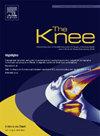人工智能预测机器人辅助全膝关节置换术中冠状位对齐
IF 1.6
4区 医学
Q3 ORTHOPEDICS
引用次数: 0
摘要
机器人辅助技术通过在全膝关节置换术(TKA)中使用更准确的骨切割来避免软组织释放。然而,理想的肢体对齐尚未建立。本研究的目的是通过相应的骨测量来预测术后膝关节冠状面对齐(CPAK)。方法本研究对530例原发性机器人辅助tka进行回顾性分析。利用机器学习预测合适的目标股骨外侧远端角(LDFA)和胫骨内侧近端角(MPTA)。在特征范围为[−1,1]的训练集上使用最小-最大标量运算对LDFA和MPTA对齐进行归一化,并分别对输入分布和目标分布进行重复。通过监督学习训练隐藏维度(16,8,4)的神经网络,从术前LDFA和MPTA测量中预测计划的LDFA和MPTA值。结果该模型在104次迭代后收敛,批大小为4,均方误差为±1.82°。该模型的回归与术前到计划冠状位对齐的假设变化一致:外翻测量被转化为中性/对齐目标,而内翻对齐被转化为较轻程度的内翻对齐。评估性统计数据表明,这种方法对膝关节形态的规划比预测平均值要准确得多(RMSE 1.440;平方0.444;纳什萨克利夫0.579)。结论本研究的模型提供了准确的目标膝关节排列形态预测。未来的工作需要评估该方法对规划机器人TKA的有用性。本文章由计算机程序翻译,如有差异,请以英文原文为准。
Prediction of coronal alignment in robotic-assisted total knee arthroplasty with artificial intelligence
Introduction
Robotic-assisted technologies provide the ability to avoid soft tissue release by utilizing more accurate bony cuts during total knee arthroplasty (TKA). However, the ideal limb alignment is not yet established. The aim of this study was to predict postoperative Coronal Plane Alignment of the Knee (CPAK) using corresponding native bony measurements.
Methods
This study analyzed a retrospective cohort of 530 primary robotic-assisted TKAs. Machine learning was utilized to predict appropriate target lateral distal femoral angles (LDFA) and medial proximal tibial angles (MPTA). Normalization of LDFA and MPTA alignments was performed using the min–max scaler operation on the training set with feature range [−1, 1] and repeated separately for the input and target distributions. A neural network of hidden dimensions (16, 8, 4) was trained via supervised learning to predict planned LDFA and MPTA values from preoperative LDFA and MPTA measurements.
Results
The model converged after 104 epochs and batch size 4 with mean squared error ±1.82°. The model’s regression agrees with the hypothesized change in preoperative to planned coronal alignment: valgus measurements are translated to neutral/aligned targets while varus alignments are translated to varus alignment of lesser severity. Evaluative statistics demonstrate this method for planning knee morphologies is significantly more accurate than making predictions about the mean (RMSE 1.440; R-squared 0.444; Nash Sutcliffe 0.579).
Conclusion
This study’s model provides accurate predictions for target knee alignment morphologies. Future work is warranted to evaluate this method’s usefulness for planning robotic TKA.
求助全文
通过发布文献求助,成功后即可免费获取论文全文。
去求助
来源期刊

Knee
医学-外科
CiteScore
3.80
自引率
5.30%
发文量
171
审稿时长
6 months
期刊介绍:
The Knee is an international journal publishing studies on the clinical treatment and fundamental biomechanical characteristics of this joint. The aim of the journal is to provide a vehicle relevant to surgeons, biomedical engineers, imaging specialists, materials scientists, rehabilitation personnel and all those with an interest in the knee.
The topics covered include, but are not limited to:
• Anatomy, physiology, morphology and biochemistry;
• Biomechanical studies;
• Advances in the development of prosthetic, orthotic and augmentation devices;
• Imaging and diagnostic techniques;
• Pathology;
• Trauma;
• Surgery;
• Rehabilitation.
 求助内容:
求助内容: 应助结果提醒方式:
应助结果提醒方式:


